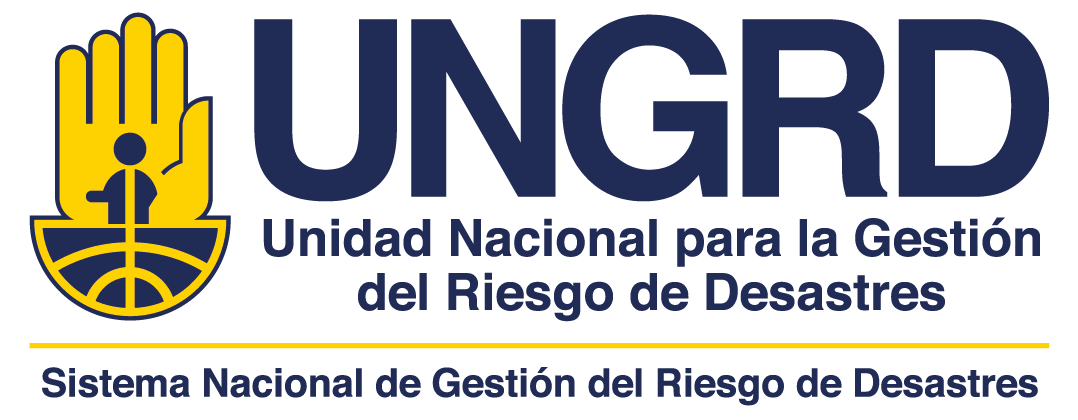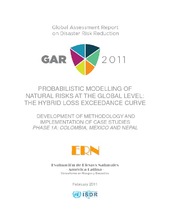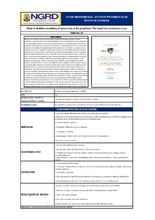Mostrar el registro sencillo del ítem
Probabilistic modelling of natural risks at the global level: The hybrid loss exceedance curve
| dc.creator | Evaluación de Riesgos Naturales - AL (ERN) | |
| dc.date.accessioned | 2016-07-28T13:31:09Z | |
| dc.date.available | 2016-07-28T13:31:09Z | |
| dc.date.issued | 2011 | |
| dc.identifier.citation | Evaluación de Riesgos Naturales - AL (ERN). (2011). Probabilistic modelling of natural risks at the global level: The hybrid loss exceedance curve Development of methodology and implementation of cases studies. Phase 1A: Colombia, Mexico and Nepal. Ginebra. International Strategy for Disaster Risk Reduction - UNISDR | |
| dc.identifier.uri | http://hdl.handle.net/20.500.11762/19870 | |
| dc.description.abstract | During recent decades, socio-economic impacts produced by disasters caused by natural phenomena are an indication of the high vulnerability of human settlements located in vulnerable areas in developing countries, as well as the levels of financial and social protection that must be provided in order to pay for associated economic losses, not only direct losses but also losses from a decrease in productivity of the agricultural and industrial sectors, a decline in tax revenues and a need to have resources available for dealing with emergencies.Vulnerability in the face of natural phenomena has increased during recent decades primarily in the developing countries throughout the world. Population growth, poverty, the growth of cities and infrastructure projects in general have increased the assets exposed in regions that can be affected by a large diversity of dangerous natural phenomena. In addition, a high level of population migration because of various social problems, unemployment, violence, insecurity of many different types and other factors force people to occupy land that is less and less suitable for human habitation, which increases exposure under undesirable conditions, leading to a considerable increase in levels of vulnerability and risk.Despite the research carried out on an international scale concerning the impact of disasters on development, formal incorporation of disaster risk in planning processes has been very timid up until now. Although most developing countries include in their budgets several allocations, primarily for preparation and dealing with emergencies, and in several cases efforts are being made to orient resources towards planning activities dealing with risk mitigation, in many countries do not calculate probabilistic losses from natural events as a permanent component of their budget process. However, if potential contingent losses are not accounted for, there is a lack of information required in order to consider and evaluate alternatives in order to reduce or pay for those losses. As a result, policies aimed at reducing risk do not really receive the attention that they require.An absence of adequate models to quantify risk in objective and non-relative terms leads to a series of important implications. The most obvious implication is that by not accounting for contingent exposure to natural hazards a country's capacity to evaluate how desirable its planning tools are to deal with risk is limited. Planning tools require that risk is reasonably quantified as a pre-existing condition in order for those planning tools to be useful. Although it is possible to take policy decisions based on rough estimates or without probabilistic estimates, by not quantifying the risk when it is possible the decision-making process is handicapped for physical planning and for reducing and financing risk. If future losses are not a component of the planning and investment process in a country, it is almost impossible to use budget resources in order to reduce potential losses. A lack of probabilistic disaster risk estimates has at least two very important serious implications: first, there is no contingency planning for the cost of future reconstruction and, second, which is the most important, the main incentive for promoting risk mitigation and prevention is lost.Many recent applications and projects have been focus on evaluating hazards in terms of statistics, making reference to the frequencies of occurrence of various levels of phenomena such as earthquakes, tsunamis, hurricanes, flooding, landslides and volcanic eruptions. Meanwhile, the assessment of vulnerability has focused primarily on establishing indices based on the number of victims caused by each disaster. Using information at the worldwide level available in certain databases (e.g. EM-DAT of the Université catholique de Louvain), correlations have been established with information available on the same events in order to establish levels of vulnerability by correlating factors. Indices are based essentially on statistical correlations and not on actuarial or physical assessments obtained from the association between the degree of hazard, exposure and vulnerability, with which can be established measurements more appropriate or taking into account the risk to which each region or area of the world is exposed.Although these indices are illustrative for effects of comparison, in general, they are deficient at the macro level for calculating risk in predictive terms. It can be stated that this type of focus is retrospective of what has occurred. In essence, they are indices of disaster and not of risk in the true sense of the word and, therefore, report indirectly and in a limited way what might occur in the future. These indices are inappropriate for determining frequency and intensity of hazards and potential losses. They do not facilitate the drafting of appropriate measures for intervention or risk mitigation, taking into account feasible and appropriate alternatives that can be described in function of their effectiveness and cost. Several of these indices developed at the global level, that have been established using indicators, illustrate the more advanced work carried out up until now of this type. A descriptive summary of the same is included in annex 1. Taking that into account, the concept paper entitled Global Assessment Report on Disaster Risk Reduction -GAR 2011 states the need to identify effective strategies for reducing various segments and strata of risk based on the application of instruments of probabilistic assessment and the availability of information on global, regional and national risks in order to identify and quantify the various strata of risk associated with various intensities and frequencies of possible consequences. In addition, it is proposed that the costs and benefits of the treatment of each of those segments and strata of risk be identified and examined, in order to sustain strategies of risk reduction taking into account the maximization of benefits for various groups of countries.This report seeks to consider the possibility of meeting the challenge of GAR 2011, given the possibility of using information that until now has been used at a level and other, global a national and sub-national levels with greater resolution. Likewise, the possibility of using sophisticated and rigorous probabilistic models, a level state of the art, which make it possible to carry out appropriate risk assessments of effect, such as those used in the insurance and reinsurance industries, but adjusted by their authors in order to reflect not only catastrophic risk, as is usually the case, but also aggregated risk in terms of multi-hazard in relevant time frames for decision-makers in the public and private sector in order to create strata of the risk and propose activities for retention, mitigation, regulation, transfer and acceptability of the risk in accordance with what is feasible in terms of public investment and optimization of resources. | |
| dc.description.sponsorship | Ingeniar LTDA, ITEC SAS, CIMNE, ERN Ingenieros consulores S.C. | |
| dc.format | Digital (.pdf) | |
| dc.language.iso | en | |
| dc.publisher | International Strategy for Disaster Risk Reduction - UNISDR | |
| dc.source | reponame:Repositorio Institucional Unidad Nacional para la Gestión del Riesgo de Desastres | spa |
| dc.source | - | |
| dc.source | instname:Unidad Nacional para la Gestión del Riesgo de Desastres | spa |
| dc.subject | Retrospective risk assessment | |
| dc.subject | prospective risk assessment | |
| dc.subject | hazard assessment | |
| dc.subject | Colombia | |
| dc.title | Probabilistic modelling of natural risks at the global level: The hybrid loss exceedance curve | |
| dc.title.alternative | Development of methodology and implementation of cases studies. Phase 1A: Colombia, Mexico and Nepal | |
| dc.type | info:eu-repo/semantics/article | spa |
| dc.description.departamento | GINEBRA | |
| dc.type.spa | Informe técnico | |
| dc.rights.accessRights | info:eu-repo/semantics/openAccess | spa |
| dc.description.volumen | Único | |
| dc.type.hasVersion | info:eu-repo/semantics/acceptedVersion | spa |
Ficheros en el ítem
Este ítem aparece en la(s) siguiente(s) colección(ones)
-
Informes [55]




